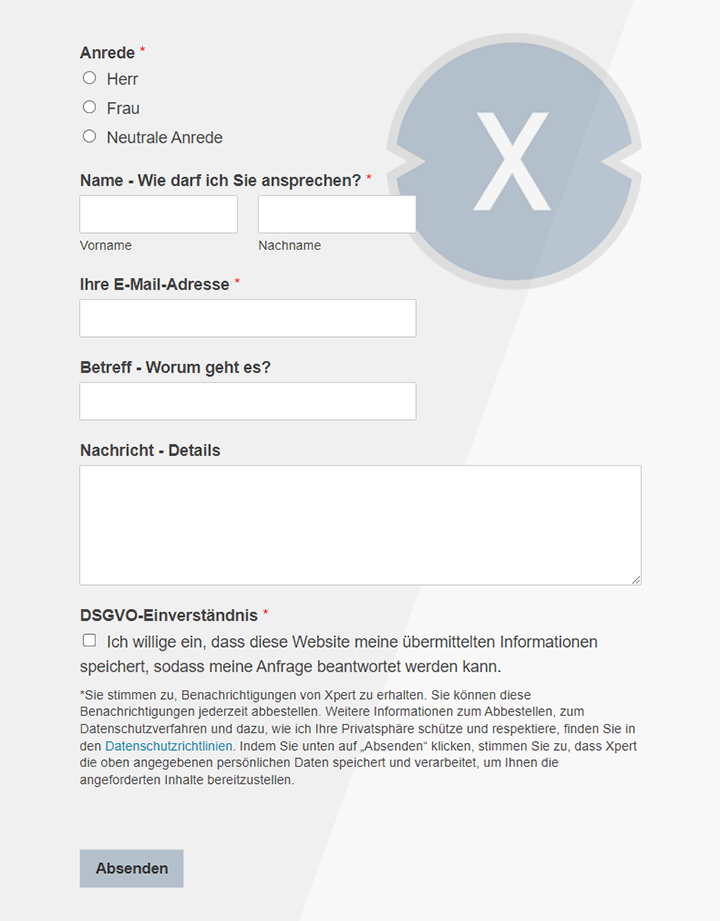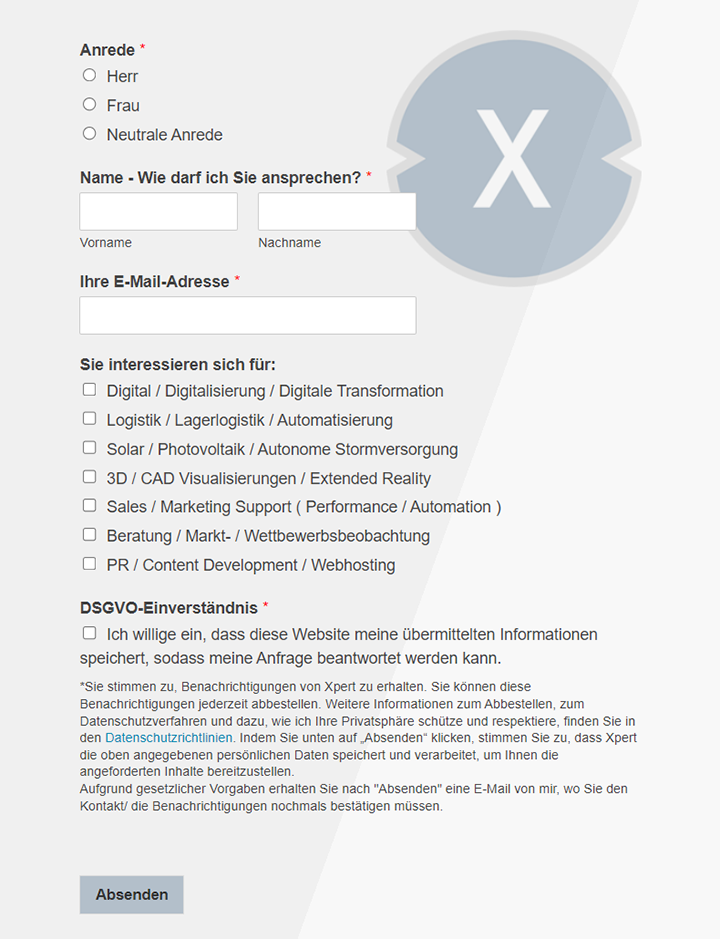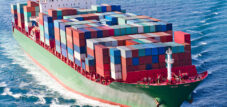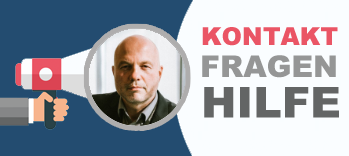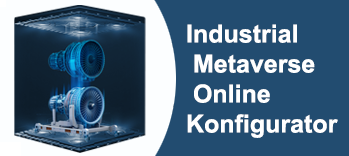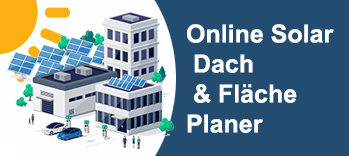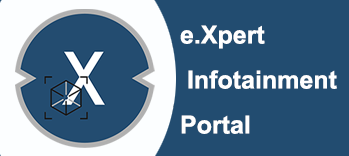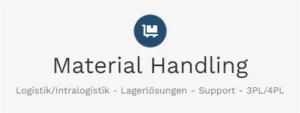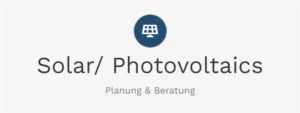System terminals buffer warehouse: multifunctional buffer bearing zones for containers and complete load trains (semi-trailer/trailer)
Xpert pre-release
Language selection 📢
Published on: April 18, 2025 / update from: April 29, 2025 - Author: Konrad Wolfenstein

System terminals buffer warehouse: multifunctional buffer bearing zones for containers and complete load trains (semi-trailer/trailer)-Image: Xpert.digital
Expansion of system terminals as a buffer warehouse for increasing efficiency and CO2 minimization in internal European freight traffic (reading time: 34 min / no advertising / no paywall)
Optimization of internal European freight traffic through extended terminal buffering
The steadily growing volume of internal European freight transport, for which an increase of almost 50 % will be forecast by 2050, presents the existing logistics infrastructure with considerable challenges. This increasingly leads to bottlenecks, delays and the associated CO2 emissions. The efficiency of terminal operations is of central importance for the performance of the entire supply chain. Terminals often act as a needle tube due to limited capacities for temporary storage (buffer zones) and inefficient envelope processes, especially during peak load times or in the event of disorders in the operating sequence. This situation is exacerbated by the requirements of “Just-in-Time” logistics, which favors flexible but often less sustainable road transports.
This report examines the strategic concept of expansion and the use of terminal areas, in particular potentially available sealed areas, as dedicated or multifunctional buffer bearing zones for containers and complete load trains (saddle trailer/trailer). The aim is to decouple the arrival and departure currents from the immediate envelope processes and thus to smooth the processes.
As part of this report, an expert assessment is carried out based on the points (1-8) formulated in the user request. The feasibility of the concept, its potential to increase logistical efficiency (Q4) and to reduce CO2 emissions (Q5) are evaluated. This includes the identification of important nodes (Q1), the analysis of the current infrastructure (Q2), the investigation of technical concepts (Q3), the analysis of challenges (Q6) and the examination of relevant case studies (Q7) to enable a well -founded overall assessment (Q8).
Suitable for:
- Individual photovoltaic (PV) parking solutions for trucks and cars reduce unnecessary costs and increase amortization
- Truckport & Truckport: A solar port with a height of up to 10 meters - solar carport for adults
Mapping of the decisive logistics hubs and system terminals in Europe
The Ten-V frame work as a strategic backbone
The policy of the Trans-European Transport Network (TEN-V), recently updated by the Regulation (EU) 2024/1679, forms the overarching strategic framework for the identification and development of the most important European transport infrastructures. The aim is to ensure the coherence of the network, reduce the environmental impact of traffic and increase resilience. The TEN-V consists of a multi-layer network (core network, extended core network, total network) with staggered completion goals (2030, 2040 or 2050), which combines the most important cities and nodes. It explicitly includes different modes of transport such as rail, street, inland waterways, ports, airports and freight traffic terminals.
Nine European traffic corridors, including strategically important axes such as Rhein-Alpen, Scandinavia Middle Sea and Baltic Sea Adria, structure the development and control of the network. Corridore relevant to the study area include, for example, Ostsee-Adria, Mediterranean and Scandinavia Middle Sea. The main traffic axes of Austria (Danube, Brenner, Baltic-Adriatic axis) are part of the core network. The TEN-V explicitly includes goods terminals and aims to promote multimodal traffic, the expansion of the infrastructure for alternative fuels and military mobility through civil-military double use of the infrastructure. Financing instruments such as Connecting Europe Facility (CEF2) prioritize projects in the TEN-V kern network, including intermodal terminals and measures to adapt the infrastructure.
Identification of important intermodal terminals
While the TEN-V defines strategic nodes (criteria for ports, airports, multimodal terminals and urban nodes are set), the identification requires more detailed data that are suitable for a buffer extension. Large European container ports such as Rotterdam, Antwerp and Hamburg are primary nodes. However, binn terminals are also crucial for internal European traffic along important rail and waterway corridors.
Resources such as the Intermodal Map of the SGKV and the map of intermodal-terminals.eu offer extensive directories that contain potentially information about equipment and services. However, explicit data on buffer capacity are often limited. Industry reports and databases list important operators and terminals in Europe. Examples of this are the container terminal dortmund (CTD), terminals from DP World, the Rail Cargo Group, Metrans etc. ..
An essential point is the discrepancy between the strategic nodes of the TEN-V, defined on the high level and the specific operational features of individual terminals, including the available space for extensions or buffer camps. The TEN-V identifies nodes based on strategic importance and connectivity goals. However, the key question refers to the physical expansion of terminals for buffer camps, which requires knowledge of specific location conditions (available areas, existing sealing, layout). Although the TEN-V terminals includes, its main focus is not on granular location data. Databases such as intermodal map or operating lists provide locations, but there are often detailed capacity or surface information. The identification of suitable terminals therefore requires the bridging of this gap between the strategic map of the TEN-V and the location-specific company realities. This requires targeted reviews or the analysis of case studies, such as those of the Duisburg Gateway Terminal.
Selection of important European intermodalter terminals for potential buffer expansion

Selection of important European intermodalter terminals for potential buffer expansion - Image: Xpert.digital
This table synthesized information from strategic framework works (TEN-V) and operational data sources to identify terminals that are both strategically important and could be relevant for the buffer concept. It addresses Q1 directly by listing and filing the large number of European terminals according to relevant criteria: strategic importance (TEN-V connection), operational size (implied by harbor rankings or naming as the main operator) and relevance for internal European traffic (focus on rail/inland hubs and large ports). This provides a manageable list of candidates for the use of the buffer concept.
A selection of important European intermodalter terminals shows potential opportunities for buffer extensions. The Duisburg Gateway Terminal (DGT) in Duisburg, Germany, is a large inland port with multimodal access via rail, water and road. It is located in the Rhein-Alpen- and North Sea Ostsee corridor and is characterized by a new construction project that focuses on efficiency, digitization and climate neutrality and offers a high capacity. The port of Rotterdam (Maasvlakte II) in the Netherlands is a highly automated seaport of considerable size, which covers both sea, rail and road transport. It lies on the corridors of North Sea Rhine and North Sea Ostsee and relies on electrification and efficiency. The port of Antwerpen-Brügge in Belgium is an important hub in the North Sea Rhine and North Sea Ostsee corridor, which invests in EV infrastructure and truck buffer parking spaces.
The port of Hamburg with the HHLA terminals is also a very large seaport in Germany, which stands out by automation (CTA), a strong intermodal network from Metrans and a clear sustainability goal. In Italy, the Quadrante Europe in Verona serves as a large Rail hub in the Scandinavia Middle Means and Mediterranean corridor and is a central knot for the alpine transit with high train frequency. The Metrans terminals, for example in Prague, Czech Republic, or Dunajská Streda, Slovakia, form a network of domestic terminals in central and Eastern Europe and are an important player in the Orient and Eastern Mediterranean. Rail Cargo terminals, such as in Vienna and Wels, Austria, concentrate on rail and road traffic and have an important function in the Baltic Sea Adria corridor.
Finally, the CTD Dortmund in Germany is a trimodal hub in the Rhein-Alpen-corridor, which is integrated by rail, road and water transports and is considered a central domestic terminal in the Ruhr area. Through their strategic location, efficient processes and multimodal accesses, all of these intermodalter terminals offer potential opportunities for buffer extensions in the European freight traffic system.
Suitable for:
- Strategic realignment of the supply chains and logistics: A requirement of the hour - at short notice, in the medium term and long -term
Current status of the terminal infrastructure: capacities and bottlenecks
Evaluation of existing buffer capacities
Container terminals naturally have storage areas (yards) that serve as temporary buffer zones. The required size of these surfaces depends on the size of the handled ships and the throughput of the terminal. However, the existing infrastructure varies considerably. Some terminals may have insufficiently used sealed areas, while other, especially smaller terminals, are faced with considerable restrictions on space and require intelligent use of every available square meter. Studies from the Alpine region provide examples of terminal areas and infrastructure data, such as total or storage areas. The port of Trieste has approximately 925,000 m² of storage space, and the quadrante Europe in Verona has around 16,300 trains in Verona.
Data availability and restrictions
An important challenge in the assessment of the current situation is the lack of centralized, standardized real -time data about terminal capacities, including buffer zones and available sealed areas. The European Commission lacks a comprehensive overview of the need for terminals in the EU. However, existing instruments such as the intermodal map or intermodal-terminals.eu offer location and basic infrastructure information, detailed and current information on capacities or buffer zones are common. There are national initiatives for mapping (e.g. in Germany and the Netherlands), but these are not available across the EU.
This lack of availability of comprehensive, accessible data on existing terminal capacities and buffer zones throughout the EU represents a significant obstacle to the strategic planning and implementation of networking of networking improvements such as the proposed buffer expansion. Effective planning requires an understanding of the current state - where are the bottlenecks, where are there unused capacity or surfaces for extensions? The European Court of Auditors explicitly finds that the Commission lacks this overview. Without this data, there is a risk that investments (e.g. via CEF2) will be made suboptimally, possibly finance projects in which the need is not greatest, or overlook opportunities in which expansion would be the most feasible and most effective. This data gap forces the dependence on fragmented information, case studies or costly individual reviews and hinders a coordinated EU-wide approach.
Identified bottlenecks and challenges
The report of the European Court of Auditors (ECA) emphasizes central problems: a lack of overview of the terminal requirement, unequal distribution of the terminals, project delays that affect capacity, inadequate track lengths in terminals (which requires time -consuming maneuvering processes) and bottlenecks in the connection infrastructure (rail, waterway).
Company inefficiencies result from difficult-to-access information (missing real-time data on terminal status/capacity), inadequate digitization, complex ownership relationships that lead to delays, as well as more general problems in the rail network (interoperability, capacity management). Traffic congestion around the terminals are also a big problem that affects the circulation times and efficiency.
🎯🎯🎯 Benefit from Xpert.Digital's extensive, fivefold expertise in a comprehensive service package | R&D, XR, PR & SEM

AI & XR 3D Rendering Machine: Fivefold expertise from Xpert.Digital in a comprehensive service package, R&D XR, PR & SEM - Image: Xpert.Digital
Xpert.Digital has in-depth knowledge of various industries. This allows us to develop tailor-made strategies that are tailored precisely to the requirements and challenges of your specific market segment. By continually analyzing market trends and following industry developments, we can act with foresight and offer innovative solutions. Through the combination of experience and knowledge, we generate added value and give our customers a decisive competitive advantage.
More about it here:
Efficient terminal management through modern buffer zones - reduction in waiting times and emissions
Technical and logistical concepts for the expansion of terminal buffer zones
Strategies for the development of buffer zones
Buffer camp act as decoupling points in the logistics chain. They absorb fluctuations in arrivals and descents and smooth the material flows between different transport companies or process steps within the terminal. In order to create such zones, existing sealed areas (e.g. less used parking spaces, maneuvering areas) can be rededicated or redesigned. Alternatively, new areas have to be opened up and sealed, which causes costs (estimate: 25 €/m² for new systems) and environmental tests (see section 8). The design of the buffer zones must take into account traffic rivers, access for envelope devices and safety aspects. Block layouts operated by portal cranes (RMGS/RTGS) enable high stacked density for containers.
Design for multiple use (container & truck)
The accommodation of standard containers and complete trucks (trailers/semi -trailers) in the same buffer system is a challenge due to different handling requirements, dimensions and dwell times. This requires flexible envelope and whitening management systems. Possible solutions include the furnishings of designated zones within the buffer area, the use of flexible devices such as ReachStacker or specialized automated vehicles as well as advanced Yard Management systems (YMS) that can manage various load carriers. Truck parking spaces, such as strategically used in Antwerp, can explicitly serve as buffer zones.
Use of automation and yard management systems (YMS)
The efficient management of large, complex buffer zones requires the use of technology. Manual systems quickly reach their limits in optimization and real -time tracking in dynamic environments. Modern YMS integrate real-time data, automated tracking technologies (e.g. RFID, DGPS), algorithms for surface optimization and inventory management. They improve transparency, reduce errors, optimize land use in yard and prevent bottlenecks. Artificial intelligence (AI) can help to predict traffic flows and to suggest optimal storage locations.
Automation technologies play a key role:
Automated stacking cranes (ASCS/ARMGS)
Increase the storage density and enable automated YARD mode. They are used in progressive terminals such as Maasvlakte II and are planned for the DGT. Ec docharts (LCA) indicate a potential for emission reduction if they are operated with renewable energy.
Automated Guided Vehicles (AGVS) / Automated Terminal Trucks (Atts)
Take over the horizontal transport between Kai/Tor and Buffer/stacking area. Electrically powered versions contribute to sustainability. Maasvlakte II uses L-AGVS and expanded to include Atts.
Automated Straddle Carrier / Portal Hubwagen
Offer flexibility when stacking and transporting and can increase the buffer capacity compared to terminal tension machines.
For a smooth operation, YMS via interfaces (APIs) with Terminal Operating Systems (TOS), gate automation systems and potentially also truck time window management systems (TAS) must be integrated to ensure seamless data flow.
The advanced automation (ASCS, AGVS) in combination with intelligent YMS is not only an efficiency driver, but a prerequisite for the effective coping with the increased complexity of large, potentially multifunctional (containers and trucks) buffer zones. The proposed concept includes larger buffer areas, which may absorb both containers and trucks. This increases the number and variety of units as well as the complexity of the processes. Manual or simple systems would be overwhelmed with the persecution, optimal placement and efficient access. Advanced automation such as ASCS/RMGs enables dense, organized stacks. AGVS/ATTs ensure efficient, automated horizontal transport. The decisive factor is a sophisticated YMS that acts as a “brain” and manages this complexity with the help of real -time data and algorithms (potentially AI), optimized space, minimized handling and ensures that the units are available if necessary. Without this technological level, there is a risk that large multi -purpose buffers will become inefficient and chaotic and the desired advantages.
Comparison of concepts for the expansion of buffers
This table helps decision -makers to understand the compromises between different implementation approaches for the buffer concept. It addresses Q3 by outlining technical/logistical concepts. It divides the general idea of the “buffer extension” into different operating models (only containers, only trucks, mixed), based on information on container stacks, truck parking and the supportive technologies. The comparison of advantages and disadvantages as well as the necessary technologies offers a structured framework for evaluation, which best suits the context of a specific terminal.
The comparison of concepts for the expansion of buffers comprises three approaches. The dedicated container buffer with high density is based on key technologies such as ASCS/RMGs and AGVS/ATTS. It is characterized by a high storage density and optimized container processes, but offers low flexibility for other units. This concept is particularly suitable for a high proportion of containers, sufficient space availability and high willingness to invest. Another approach is the dedicated truck buffer car park, which is supported by intelligent parking space management and possibly security features. The advantages are the simple implementation and clear separation for trucks, while the lower area density and the exclusive use for trucks are considered disadvantages. The suitability depends on a high proportion of truck, the need for waiting zones and the availability of separate areas. Finally, there is the mixed buffer zone that uses flexible envelope devices such as ReachStacker, an advanced Yard management system (YMS) and, if necessary, AGVs. This concept offers high flexibility for different units, but brings high complexity in management and potentially a lower density. It is particularly suitable for a variable mix of containers and trucks as well as a need for flexibility.
Efficiency increase: Effects of extended buffer warehouse
Optimization of the terminal processes
Buffer zones decouple different process steps within a terminal. This enables kaikranes, yard equipment and gate operations to work more independently and more continuously, which reduces idle times caused by unequal river rates. An unproductive container cutting (Rehandles) in Yard reduces unproductive container cutting through YMS and automation. The possibility of pre-sorting (pre-stacking) of containers according to their further transport modality, as is practiced on Maasvlakte II, is only made possible by sufficient buffer capacity and improves throughput and the direct availability of the containers.
Reduction of waiting times and improvement in circulation times
The truck circulation time (Truck Turnaround Time, TTT) is a decisive service indicator for terminals. Long queues and waiting times at the gates and within the yards are the main causes of inefficiency and costs. Sufficient buffer capacities prevent traffic jams in the yard from to the gate, which enables more smooth truck handling. For delivering or picking up trucks, a proven waiting/buffer area (such as the truck parking spaces in Antwerp) prevents the access routes of the terminal that are released too early. Shorter waiting times lead to faster TTT, a better utilization of the vehicles for transport companies and lower operating costs.
Synergies with truck time window management systems (TAS)
Truck time window management systems (Truck Appointment Systems, TAS) aim to smooth the truck arrivals by avoiding tips and valleys. This is done by having to book time windows for delivery or collection. This improves predictability and workload management for the terminal operator.
Extended buffer capacities make the terminal more resistant to deviations from the TAS time plans (e.g. delayed or premature arrivals). They offer physical space to catch these fluctuations without causing immediate standstill. Conversely, a TAS helps to control the demand for buffer areas and avoid overload. Studies show that TAS reduces the TTT and traffic jams. The combination of TAS with optimized buffer management (possibly using models such as the proposed MILP model) can improve service quality not only for trucks, but also for other modes of transport (trains, inland ships) by enabling better resource allocation (e.g. Straddle Carry). The cooperation between terminals and transport companies via TAS can increase the overall efficiency.
Extended buffer capacities and truck time window management systems (TAS) are therefore highly complementary tools. Buffers offer physical resilience compared to fluctuations in the flow of traffic, while TAS enables the planning and control of demand. The implementation of both systems promises larger efficiency gains than any solution in itself. TAS aims to control the truck. However, the reality in the company contains variability (traffic, delays), so that perfect compliance is unlikely. Without sufficient buffer room, even slight deviations can lead to traffic jams in a TAS-controlled river. Conversely, a large buffer could be overloaded without demand management (such as TAS) at persistent tips. Buffers offer the physical capacity to compensate for imperfections in the TAS time plan. TAS provides the planning framework to prevent constant overloading of the buffer and helps the terminal to effectively assign resources based on the expected arrival. Therefore, they work best by addressing both the physical capacity and river management.
Suitable for:
- Resilience through diversification: Strategic realignment of global supply chains in the geopolitical area of tension
Environmental advantages: Evaluation of the CO2 reduction potential
Reduced idle emissions
Trucks that wait at goals or within terminals consume fuel and emit CO2 and other pollutants. Yard equipment such as cranes and tractors also contribute significantly to emissions, especially if they are diesel companies. By shortening waiting times and the smoothing of the traffic flows, minimizing expanded buffers in combination with TAS the idle for both trucks and internal envelope. Studies establish an explicit relationship between TAS implementation and the reduction of carbon emissions due to reduced idle and optimized schedule. Models for quantification of these savings exist. Case studies show considerable potential; The optimization of truck speeds and energy mixes could save megatons on CO2 equivalents over time. Collaborative logistics approaches to reduce empty trips also lead to considerable CO2 savings.
Facilitation of the Modal Shift
Efficient and reliable intermodal terminals are crucial to make rails and inland navigation transports competitive compared to pure road transport. By improving terminal efficiency and reducing the delays associated with intermodal um loads, expanded buffers can make combined traffic more attractive. The shift of goods from the road to rail or water offers significant CO2 reduction potential. Ten-V politics explicitly supports this relocation.
Although direct emission reductions are significant due to less idle, there is a potentially larger, long -term environmental advantage of expanded buffer capacity in their ability to improve the efficiency and reliability of intermodal terminals. This makes it easier to relocate goods from the road to low -emission modes of transport such as rail and water. The immediate benefit of buffers/TAS are reduced idle emissions. However, the overarching goal is CO2 minimization in the entire internal European traffic (user request). A main lever for this is the Modal Shift. The attractiveness of intermodal traffic depends heavily on the efficiency and reliability of the terminal operations (transshipment points). Are terminals overloaded and slowly, despite higher emissions, the shippers prefer direct road transport. By improving the terminal throughput and reducing delays (Section 6), expanded buffers make intermodal options more competitive. This promotes a relocation away from long-distance truck traffic, which potentially leads to larger overall CO2 savings over the entire transport chain than just the savings through reduced idling at the terminal itself.
Synergy with electrification and automation
Modern projects for the expansion of buffers often go hand in hand with automation and electrification (e.g. DGT; Maasvlakte II). Automated equipment such as ASCs and AGVs is often electrically operated. The use of renewable energies to supply these devices, as planned in the DGT with hydrogen and photovoltaics, reduces the operational CO2 footprint of the terminal compared to diesel-powered processes. Ecclassicity studies confirm the advantages of electrification.
Implementation hurdles: challenges, costs and regulatory aspects
Operative and logistical hurdles
Restrictions on space: Finding enough space for extensions within existing terminal limits can be difficult, especially in densely built -up port areas.
Integration complexity: The integration of new buffer zones and the associated technologies (automation, YMS) in existing terminal processes and IT systems requires careful planning and execution.
Coordination: Effective use, especially of multi-purpose buffers or jointly used truck parking spaces, requires coordination between terminal operators, freight forwarders, rail operators and shipping companies. The data exchange is crucial, but often poor.
Disorders during implementation: The redesign of existing areas or the new building can interfere with ongoing operation.
Investment requirement
High capital costs: Automation and large -scale infrastructure extensions represent considerable, often irreversible investments. The cost of phase 1 of the DGT was around € 120 million. This includes land advertising/preparation, paving/sealing (estimate: 25 €/m² for new systems), equipment (cranes, AGVs) and technology (YMS, sensors).
Area sealing costs: In addition to the pure construction costs, the sealing of space causes follow -up costs for drainage systems and potentially for environmental reduction measures.
Sources of financing: EU funds such as CEF2 can support projects, especially in the TEN-V Kernnetz and for innovation/sustainability. For example, the DGT received funding. However, the total investment requirement for the TEN-V far exceeds the available EU funds.
The regulatory environment
TEN-V/CEF regulations: regulate network planning and the eligibility of projects. Projects must match the TEN-V goals (efficiency, sustainability, multimodality).
Transport operating regulations: EU regulations regulate the market access for road freight traffic (community license), potentially weights and dimensions (mentioned suggestions for alternative drives/cranisable trailers) and combined transport (Directive 92/106/EEC, possibly in revision).
Environmental impact assessment (RRP): The EU Directive 2011/92/EU, changed by 2014/52/EU, prescribes a RRP for projects that are expected to have significant environmental impacts. This applies to the construction or change of larger infrastructure systems. The process includes a screening (determination of the UVP obligation), scoping (determination of the framework of the examination), the creation of a UVP report, public participation and the decision of the authority. There are threshold values (e.g. size, location in protected areas) that trigger an obligatory RRP or screening. Extension projects can trigger a RRP. Cumulative effects with other projects must be taken into account. This process causes additional time and costs and creates uncertainty in the project permit.
While securing funding (e.g. via CEF2) is a challenge, coping with the environmental approval process (RRP) for physical terminal expansion is a significant, potentially lengthy and complex regulatory hurdle, which must be included in project schedule and feasibility ratings. The concept of the user request includes the expansion of terminal areas, which often implies construction work and potentially the sealing of new areas. The sources clearly describe the EU UVP directive and its national implementation. This is not a mere formality, but a legally required procedure for projects from a certain size or with potential effects. It requires detailed environmental studies, public consultations and can be subject to legal challenges. This process can take considerable time and resources regardless of the financing or compliance with transport regulations. Therefore, the feasibility of the physical expansion of terminals for buffers not only depends on technical and economic factors, but decisively on coping with the complex RRP requirements.
Overview of relevant EU regulations/guidelines
This table offers a structured overview of the multi -layered regulatory environment that influences terminal expansion projects. It addresses Q6 regarding the regulations. It consolidates important legal files that are mentioned in the snippets and directly influence the planning, financing, construction and operation of extended terminal systems. This helps stakeholders to quickly record the most important legal framework and requirements.
The TEN-V Regulation (EU) 2024/1679 defines the network and places requirements for infrastructure and corridors. It is crucial for the strategic relevance and forms the basis for eligibility. The CEF2 Regulation (EU) 2021/1153 determines financing criteria, high -quality rates and the prioritization of the core network. This regulation serves as the most important source of financing for TEN-V projects and enables the expansion to be co-financing. The UVP Directive 2011/92/EU, changed 2014/52/EU, regulates the triggers for the environmental impact assessment (RRP), the procedural steps and public participation. She prescribes an mandatory exam for significant new construction and change projects and thus influences both the schedule and the costs. Directive 92/106/EEC for combined traffic defines and promotes it and creates framework conditions for intermodal operations, which are to be supported by the establishment of buffers. Finally, street transport regulations, such as 1072/2009, regulate market access through community licenses, cabotage and, if necessary, weights and dimensions. They thus set basic operational rules for truck traffic to and from the terminal.
🎯📊 Integration of an independent and cross-data source-wide AI platform 🤖🌐 for all company matters

Integration of an independent and cross-data source-wide AI platform for all company matters-Image: Xpert.digital
Ki-Gamechanger: The most flexible AI platform-tailor-made solutions that reduce costs, improve their decisions and increase efficiency
Independent AI platform: Integrates all relevant company data sources
- This AI platform interacts with all specific data sources
- From SAP, Microsoft, Jira, Confluence, Salesforce, Zoom, Dropbox and many other data management systems
- Fast AI integration: tailor-made AI solutions for companies in hours or days instead of months
- Flexible infrastructure: cloud-based or hosting in your own data center (Germany, Europe, free choice of location)
- Highest data security: Use in law firms is the safe evidence
- Use across a wide variety of company data sources
- Choice of your own or various AI models (DE, EU, USA, CN)
Challenges that our AI platform solves
- A lack of accuracy of conventional AI solutions
- Data protection and secure management of sensitive data
- High costs and complexity of individual AI development
- Lack of qualified AI
- Integration of AI into existing IT systems
More about it here:
Forward -looking logistics terminals: What Europe can learn from pioneers
Pontamentally examples: case studies from European terminals
Duisburg Gateway Terminal (DGT): Climate-neutral, digital inland hub
The DGT is a new, large trimodales (inland ship, rail, truck) Terminal in the port of Duisburg, built on a former coal island. After completing its complete completion, it will be the largest in Europe. It increases Duisport's cover capacity by 850,000 TEU per year on an area of 235,000 m². The infrastructure comprises 6 (expandable to 12) block cable tracks with over 730 m in length and 6 berths for inland ships. The investment for the first phase was around 120 million euros. Technologically, the DGT relies on fully digitized processes and automation (crane systems planned) in order to achieve high productivity and proximity to the market. A core aspect is the goal of climate neutrality by the 'Enerport II' project. This uses hydrogen (fuel cells, motors), photovoltaics and battery storage in an intelligent local energy network (microgrid). The DGT is highly relevant because it demonstrates a large -scale expansion of a bent terminal, integrates digitization and automation for increasing efficiency and places a strong focus on climate neutrality - all central aspects of the examined question.
Rotterdam Maasvlakte II: benchmark in automation
The terminals on the Maasvlakte II (APMT MVII, RWG) are highly automated deep-sea container terminals that were built on new territory. You have automated Kaikrane (SQCS) with double-stroke spreader, driverless transport systems (lift AGVs) for horizontal transport and automatic stacking cranes (ARMGS) in the storage area. The purchase of 30 additional electrical automated terminal trucks (Atts) was recently commissioned. The terminals are designed for the handling of the largest container ships and achieve a quick throughput through pre -sorting according to modality. Automation in completely delimited areas also increases security. The equipment is largely electrified, with Kaikrane recovering energy back and are battery operations L-AGVS. The connection via the Betuwe railway line is essential. The mention of container Freight Station (CFS) activities indicates buffer and consolidation functions. Maasvlakte II shows the state of the art in terms of terminal automation and its role for efficiency and capacity, in particular the automated storage areas that are relevant for buffer concepts, as well as the advantages of electrification.
Hafen Antwerpen-Brügge: Strategic truck parking spaces as a buffer
The port has set up large, secure truck parking spaces (Goordijk with 210 seats, Ketenis with 280 seats) near the terminal zones. These not only serve as safe resting places, but are explicitly intended to act potentially as a waiting/buffer parking spaces for trucks that arrive at their terminals too early. The parking spaces offer corresponding facilities (sanitary, WLAN, meals) and security features (fencing, cameras). Real-time occupancy data are available. The project addresses known problems with wild trucks. An important aspect is sustainability: the investment included the renovation of the site, and fast charging stations for e-trucks are planned at both locations to create a “green corridor” between Antwerp and Zeebrügge. This example is directly relevant, since it demonstrates the use of dedicated, managed truck parking areas as a buffer strategy for the control of terminal rides and to reduce traffic jams, which corresponds to the question after truck buffering and also establishes a connection to sustainability through EV charging infrastructure.
HHLA Hamburg: Network integration, automation & sustainability
Hamburg port and Logistik AG (HHLA) operates several terminals in Hamburg (e.g. CTA, Burchardkai) and internationally (Tallinn, Trieste). She has a strong focus on intermodal traffic through her subsidiary Metrans. HHLA is a pioneer of automation; The Container Terminal Altenwerder (CTA) has been almost fully automated since 2002 and uses automated processes, AGVs and automatic stock blocks. Another focus is on the digitization of the supply chains. The HHLA pursues ambitious sustainability goals and strives for climate neutrality by 2040. The CTA is already considered a climate -neutral terminal. The HHLA is currently testing hydrogen fuel cell technology for envelope (empty container truck, terminal tractor) and offers climate-friendly envelope and transport (HHLA PURE). The expansion of warehouse blocks on the container terminal Burchardkai (CTB) was also realized to increase efficiency and capacity. HHLA is an example of a large European hub that integrates terminal operation with a strong intermodal network, uses automation to increase efficiency and pursues ambitious sustainability goals, including researching hydrogen - all relevant facets of the examined question.
Suitable for:
- City – country – logistics and future-proof logistics strategies: The integration of nearshoring and buffer warehouses
Overall rating and strategic recommendations
Synthesized feasibility analysis
Technical feasibility: The expansion of sealed areas and the implementation of buffer camps for containers and/or trucks can be technically realized with existing and developing technologies (automation, YMS). Multi -purpose concepts are complex, but can be implemented with advanced management.
Economic load -bearing capacity: requires considerable investments in construction and technology. The benefits result from efficiency increases (higher throughput, faster orbit times, better system utilization) and potentially lower operating costs (saving costs due to automation, lower fuel consumption due to less idle). The profitability depends heavily on the occupancy, the efficiency gains and the financing conditions. EU funding can partially cover the costs.
Environmental potential: clear potential for CO2 reduction through minimized idle (truck, equipment), optimized processes and the enabling of electrification/alternative fuels. Significant indirect potential by facilitating the Modal Shift on rail/waterway.
Key factors for success: automation, digitization (YMS, TAS, data exchange), strategic planning, cooperation between stakeholders.
The biggest hurdles: high initial investments, lack of space at existing locations, regulatory complexity (in particular RRP in the event of physical expansion), data fragmentation/lack of transparency, integration challenges, potential concerns of workers regarding automation.
Recommendations for action
For terminal operators
Implementation of location -specific ratings of potential buffer expansion areas (sealed areas) and the capacity requirement.
Investation in advanced YMS and examination of step -by -step automation strategies (starting at Tor/Yard) to cope with the buffer complexity and increase efficiency.
Implementation or improvement of TAS in coordination with the buffer capacity planning.
Cooperation with transport partners in data exchange and operational coordination.
Prioritization of electrification and renewable energy sources for new equipment and extensions.
For political decision -makers (EU & National)
Improvement of data acquisition and transparency regarding terminal capacities, bottlenecks and space availability in the entire TEN-V network. Support for the development of standardized data platforms.
The tightening and harmonization of approval procedures, in particular the RRP, while maintaining high environmental standards (check specific guidelines for logistics infrastructure).
Continuation of financial support (e.g. CEF) for terminal modernization, digitization, automation and buffer capacity projects, whereby projects should be prioritized with clear efficiency and CO2 reduction advantages.
Promotion of standards for interoperability (physically and digital) between terminals, transport companies and IT systems.
Creating incentives for the modal shift through supportive policies for intermodal traffic and potentially through CO2 pricing mechanisms.
For logistics service providers
Active participation in TAS programs and collaboration with terminals in arrival planning.
Investing in fleet modernization (e.g. euro standards, alternative drives) to reduce emissions during terminal access and during waiting times.
Checking collaborative logistics models for reducing empty trips (relevant for feeder/custody traffic in connection with buffer operations).
Future of logistics: Intelligent buffer strategies for sustainability and resilience
The integration of intelligent buffer strategies, enabled by digitization and automation, will be crucial to improve the resilience, efficiency and sustainability of the European logistics network. These strategies must be embedded in the overarching development of the Ten-V and the goals of the Green Deal. The trend towards climate -neutral terminals, such as the DGT, is expected to accelerate, which means that buffer extensions become part of larger sustainability transformations. The ability to effectively buff and control traffic flows will be an essential competitive factor for logistics nodes of the future.
Advice - planning - implementation
I would be happy to serve as your personal advisor.
Head of Business Development
Chairman SME Connect Defense Working Group
We are there for you - advice - planning - implementation - project management
☑️ SME support in strategy, consulting, planning and implementation
☑️ Creation or realignment of the digital strategy and digitalization
☑️ Expansion and optimization of international sales processes
☑️ Global & Digital B2B trading platforms
☑️ Pioneer Business Development
I would be happy to serve as your personal advisor.
You can contact me by filling out the contact form below or simply call me on +49 89 89 674 804 (Munich) .
I'm looking forward to our joint project.
Xpert.Digital - Konrad Wolfenstein
Xpert.Digital is a hub for industry with a focus on digitalization, mechanical engineering, logistics/intralogistics and photovoltaics.
With our 360° business development solution, we support well-known companies from new business to after sales.
Market intelligence, smarketing, marketing automation, content development, PR, mail campaigns, personalized social media and lead nurturing are part of our digital tools.
You can find out more at: www.xpert.digital - www.xpert.solar - www.xpert.plus












